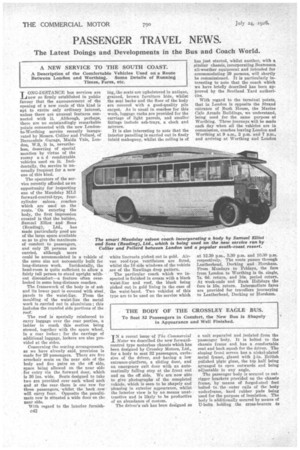THE BODY OF THE CROSSLEY EAGLE
Page 64

Page 65

If you've noticed an error in this article please click here to report it so we can fix it.
To Seat 32 Passengers in Comfort, the New Bus is in Appearance and Well Finished.
IN a recent issue of The Commercial Motor we described the new forwardcontrol type motorbus chassis which has been designed by Crossley Motors, Ltd., for a body to seat 32 passengers, exclusive of the driver, and having a low entrance-platform, a sliding door, and an emergency exit door with an automatically falling step at the front end and on the off side. We are now able to give photographs of the completed vehicle, which is seen to be shapely and pleasing in exterior appearance, whilst the interior view is by no means unattractive and is likely to be productive of an abundance of custom.
The driver's cab has been designed as
a unit separated and isolated from the passenger body. It is bolted to the chassis frame and has a comfortable seat and back squab for the driver. The sloping front screen has a nickel-plated metal frame, glazed with /-in. British polished plate glass, the top half being arranged to open outwards and being adjustable to any angle.
The passenger body is secured to outrigger brackets provided on the chassis frame, by mettles of forged-steel feet bolted to, the outer rails of the body underframe, hard rubber pads being used for the purpose of insulation. The body is additionally secured by means of U-bolts holding the cross-bearers to the chassis frame side-members. The framing of the body is suitably reinforced with steel flitch plates and the pillars are of teak. The outer panelling is of Honduras baywood (with the exception of the corners, which, being shaped, are of 18-gauge sheet aluminium), the interior below the waistline being lined with mahogany-faced plywood, whilst the garnish rails, capping rails, pillars and roof-stick mouldings are of polished mahogany. The inside of the roof and of the r4 framework above the garnish M rails is enamelled white.
The seats are mounted on adjustable pedestals, the transverse seats having semi-bucket type spring-steel back rests, the cushions being built up on strong flexible spring cases, stuffed with horsehair and trimmed with first. quality leather. The back rests are covered with rep to match the leather work.
The cant-rail on each side of the vehicle is arranged to form a wind tunnel, having metal louvre-type wind scoops outside and ventilation holes connecting with the interior of the bus
to exhaust the impure air. All windows are fitted with i-in. polished plate glass and two on each side are arranged to open. Glass louvres fitted over the drop windows serve to prevent the entry of rain through partially open windows in bad weather. All the interior fittings, ,handles, guard rails, etc., are of polished aluminium, although the maker is prepared to supply iron forgings finished in Duroid or other covering of equal quality.












































































































